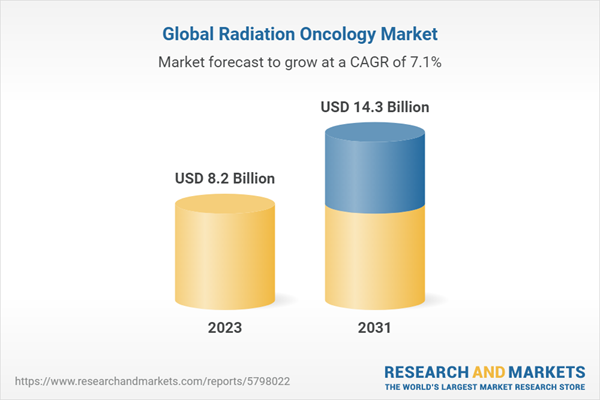Introduction
Radiation oncology, also known as radiation therapy, is a crucial component of cancer treatment that utilizes high-energy radiation to destroy cancer cells and shrink tumors. It is employed in various cancer types and can be delivered externally or internally, depending on the specific treatment approach.Key Trends in the Radiation Oncology Market
Some key trends involved in the radiation oncology market are as follows:- Technological Advancements: Radiation oncology is witnessing significant advancements in technology, leading to more precise and targeted treatments. Techniques such as intensity-modulated radiation therapy (IMRT), stereotactic body radiation therapy (SBRT), and proton therapy are increasingly being used to deliver radiation more precisely to the tumor while minimizing damage to surrounding healthy tissues. These advancements enhance treatment outcomes and reduce side effects
- Personalized Treatment: The field of radiation oncology is moving towards personalized treatment approaches, where treatment plans are tailored to individual patients based on their specific tumor characteristics, overall health, and genetic factors. This allows for more precise and effective treatment delivery while minimizing the impact on healthy tissues
- Integration of Imaging and Treatment Planning: Advanced imaging technologies, such as magnetic resonance imaging (MRI), positron emission tomography (PET), and computed tomography (CT), are being integrated into radiation oncology workflows. These imaging modalities provide detailed information about tumor characteristics, enabling more accurate treatment planning and targeting
Radiation Oncology Market Segmentations
Market Breakup by Type
External Beam Radiation Therapy
- Linear Accelerators (Linac)
- Compact advanced radiotherapy systems
- Cyberknife
- Gamma Knife
- Tomotherapy
Proton Therapy
- Cyclotron
- Synchrotron
Internal Beam Radiation Therapy
- Brachytherapy
- Seeds
- Applicators and After loaders
- Electronic Brachytherapy
- Systemic Beam Radiation Therapy
- Others
Market Breakup by Technology
External Beam Radiation Therapy
- Image-Guided Radiotherapy (IGRT)
- Intensity Modulated Radiotherapy (IMRT)
- Stereotactic Technology
- Proton Beam Therapy
- 3D Conformal Radiotherapy (3D CRT)
- Volumetric Modulated Arc Therapy (VMAT)
Brachytherapy
- Low-Dose Rate Brachytherapy
- High-Dose Rate Brachytherapy
Market Breakup by Applications
External Beam Radiation Therapy
- Prostate Cancer
- Breast Cancer
- Lung Cancer
- Head and Neck Cancer
- Colorectal Cancer
- Others
Internal Beam Radiation Therapy
- Prostate Cancer
- Gynecological Cancer
- Cervical Cancer
- Breast Cancer
- Penile Cancer
- Others
Market Breakup by Region
North America
- United States of America
- Canada
Europe
- United Kingdom
- Germany
- France
- Italy
- Others
Asia Pacific
- China
- Japan
- India
- ASEAN
- Australia
- Others
Latin America
- Brazil
- Argentina
- Mexico
- Others
Middle East and Africa
- Saudi Arabia
- United Arab Emirates
- Nigeria
- South Africa
- Others
Radiation Oncology Market Scenario
The global market for radiation oncology, or radiation therapy, is experiencing steady growth due to the increasing prevalence of cancer worldwide and the rising demand for effective cancer treatment options. Radiation oncology plays a crucial role in cancer care, offering a non-invasive and targeted approach to destroy cancer cells while minimizing damage to healthy tissues.The market is driven by several factors, including technological advancements in radiation therapy devices, growing awareness and adoption of early cancer detection and treatment, and the increasing burden of cancer-related diseases. Additionally, the rising geriatric population and the subsequent increase in cancer cases among the elderly are contributing to the market growth.
The market is driven by a combination of factors, including the demand for advanced cancer treatment options, the need for improved patient outcomes, and the growing focus on personalized medicine. Additionally, increasing investments in research and development activities, collaborations between industry players and research institutions, and government initiatives to enhance cancer care infrastructure are driving the market growth.
Overall, the radiation oncology market is anticipated to witness significant growth in the coming years. Advancements in technology, increasing cancer cases, and a growing focus on personalized medicine are expected to drive the market forward. However, challenges such as the high cost of radiation therapy and reimbursement issues in certain regions may hinder market growth to some extent.
Radiation Oncology Market: Competitor Landscape
The key features of the market report include patent analysis, grants analysis, clinical trials analysis, funding and investment analysis, partnerships, and collaborations analysis by the leading key players. The major companies in the market are as follows:- Accuray Incorporated
- Elekta AB
- Isoray Medical
- Mevion Medical Systems
- BD
- ICAD,Inc
- Isoray, Inc
- Optivus Proton Therapy, Inc
- P-Cure
- Sensus Healthcare
Table of Contents
Companies Mentioned
- Accuray Incorporated
- Elekta Ab
- Isoray Medical
- Mevion Medical Systems
- Bd
- Icad,Inc.
- Isoray, Inc
- Optivus Proton Therapy, Inc.
- P-Cure
- Sensus Healthcare
Table Information
| Report Attribute | Details |
|---|---|
| No. of Pages | 147 |
| Published | May 2023 |
| Forecast Period | 2023 - 2031 |
| Estimated Market Value ( USD | $ 8.2 Billion |
| Forecasted Market Value ( USD | $ 14.3 Billion |
| Compound Annual Growth Rate | 7.1% |
| Regions Covered | Global |
| No. of Companies Mentioned | 10 |









